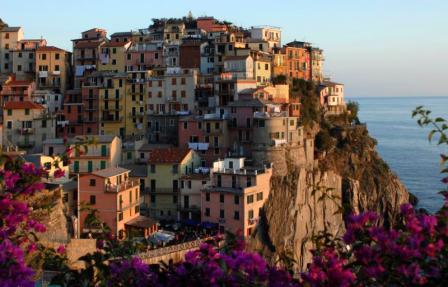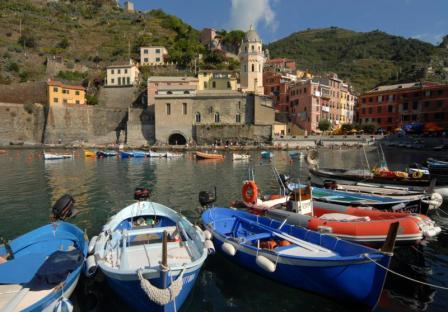By boat or by train? And onwards on foot!
 The Blue Path, Sentiero Azzurro n. 2 ties the five Cinque Terre together. The Regional Park Entity requires foot travelers to pay toll – the toll card can be purchased at Information Points at the train stations.
The Blue Path, Sentiero Azzurro n. 2 ties the five Cinque Terre together. The Regional Park Entity requires foot travelers to pay toll – the toll card can be purchased at Information Points at the train stations.
The first of the (“five lands”) Cinque Terre is Monterosso al Mare. On flatter land than the other four, it spreads out across two sandy bays. Piazza della Marina is its geographical center with its Loggia del Podestà and the parish Church of S. Giovanni Battista. The narrow street that flanks the church takes you to the arcaded porticos of Buranco where many taverns and wine bars are found (specializing in the extraordinary Sciacchetrà, one of Italy’s best dessert wines) along with artisan studios and souvenir shops. Even the anchovies in Monterosso are famous – they are red in color, and eaten raw with lemon, olive oil and oregano, or else fried with potatoes.
The path to Mesco begins at the statue of Neptune, 14 meters (45 feet) tall, called “The Giant”. But its fame derives from the villa belonging to Eugenio Montale, the Ligurian winner of the Nobel Prize for Literature. This is where he would spend his holidays, writing poetry, including his famous collection, “Cuttlefish Bones”.
Reached on foot, but also by car, is the Sanctuary of the Madonna di Soviore. This grouping of buildings with its church, bell tower, and hostel for travelers faces onto the little piazza that is adorned by centuries old oaks. In the summer picturesque concerts are held here.
 Vernazza has the only natural harbor in the Cinque Terre. It still conserves part of its protective town walls, a tower, and the castle with an extraordinary panoramic view. The town’s architecture is rustic with house-towers, porticos, and carved stone portals. The Church of S. Margherita di Antiochia, erected on a spur of rock in 1318, is in Ligurian gothic style.
Vernazza has the only natural harbor in the Cinque Terre. It still conserves part of its protective town walls, a tower, and the castle with an extraordinary panoramic view. The town’s architecture is rustic with house-towers, porticos, and carved stone portals. The Church of S. Margherita di Antiochia, erected on a spur of rock in 1318, is in Ligurian gothic style.
The path to Corniglia is among the most beautiful in the Cinque Terre. The village is on a promontory – to reach the sea you must descend 377 steps. Surrounded by vineyards, it has maintained it agricultural character. It S. Pietro parish church is one of the most interesting Ligurian gothic monuments in the Cinque Terre, and on its main (little) piazza is the Oratory of the Disciples of St. Catherine that dates to the 1700s.
Manarola, the fourth of the Cinque Terre, sits on a high spur of dark rock that juts into the sea. Its Church of S. Lorenzo dominates the scene. Manarola is also famous for its Christmas crèche, designed and built on the hills above the village by Mario Andreoli. 9,000 light bulbs, lit by solar energy, delineate the outlines of 250 statutes, some of which are three meters (10 feet) tall. The Via dell’Amore begins here, and leads on to Riomaggiore. One of the most famous sea promenades in the world – due both to its beauty and to its breath-taking cliffs – according to “TripAdvisor” (the world’s biggest travel website), here lovers can experience the eighth most romantic sunset on Earth. Riomaggiore is the last of the five lands, and it connects by road to La Spezia. The village rises up the steep slopes with winding alleyways and “stepped houses”, up to the Church of S. Giovanni Battista, built in 1340.
The Gulf of the Poets
La Spezia is the gateway to fortress-town of Portovenere, on its magnificent bay facing the Island of Palmaria. Portovenere (“Venus’ Port”) is dominated by its castle, which is reached through the ancient gates in the town wall. On the far end of the promontory, on the ruins of a temple dedicated to Venus, the beautiful Church of S. Pietro rises with its façade in stripes of black and white marble. Inside the Church of S. Lorenzo, you can admire a double painting, much revered by the local populace, which portrays the White Madonna, the patron saint of the town. The night procession dedicated to her is held on August 17, filling the darkness with the light of 2,000 torches.
To the east of La Spezia is San Terenzo, which lies in the shadow of its castle on a spur of rock above the sea. Many writers and artists have stayed in these parts, like Shelley, Byron, D.H. Lawrence, and Virginia Wolf. On the promontory sits Villa Marigola whose guests have included symbolist painter Arnold Böcklin, Italian patriot D’Annunzio, and Sem Benelli who gave the gulf its name, “The Gulf of the Poets”.
Lerici, on its beautiful bay protected by a castle, is a village that still retains its medieval town layout. It has an interesting Jewish quarter, the Oratory of S. Rocco, the Church of S. Francesco, and Palazzo Doria between the old harbor and the castle. Via Zanelli is a series of ramp-like stairs which climbs past the old houses and vegetable gardens to the castle. Now a Geo-Paleontology Museum, it is unique in Europe for its scientific importance, and has one of only two seismic simulation halls in Europe. The road to Lerici then winds further along the rugged coast to Fiascherino and Tellaro.